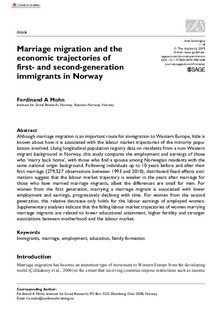Marriage migration and the economic trajectories of first- and second-generation immigrants in Norway
Peer reviewed, Journal article
Published version
Permanent lenke
http://hdl.handle.net/11250/2601200Utgivelsesdato
2019Metadata
Vis full innførselSamlinger
- Publikasjoner fra CRIStin [715]
- Rapport/Avhandling ISF [367]
Sammendrag
Although marriage migration is an important route for immigration to Western Europe, little is known about how it is associated with the labour market trajectories of the minority populations involved. Using longitudinal population registry data on residents from a non-Western migrant background in Norway, this study compares the employment and earnings of those who ‘marry back home’, with those who find a spouse among Norwegian residents with the same national origin background. Following individuals up to 10 years before and after their first marriage (279,527 observations between 1993 and 2010), distributed fixed effects estimations suggest that the labour market trajectory is weaker in the years after marriage for those who have married marriage migrants, albeit the differences are small for men. For women from the first generation, marrying a marriage migrant is associated with lower employment and earnings, progressively declining with time. For women from the second generation, this relative decrease only holds for the labour earnings of employed women. Supplementary analyses indicate that the falling labour market trajectories of women marrying marriage migrants are related to lower educational attainment, higher fertility and stronger associations between motherhood and the labour market.
